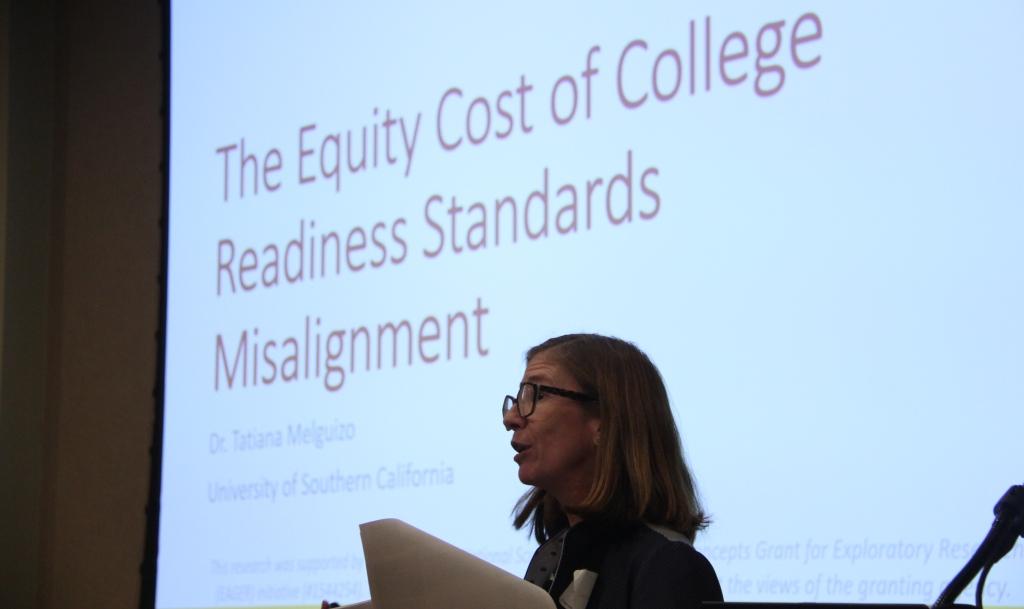
Tatiana Melguizo: Let’s Make Math Equity in Higher Education a Reality
A substantial majority of low-income, first-generation and racially-minoritized students begin their college journeys in community colleges. Rigorous empirical research nationwide has documented that a major road block for community college students to earn a certificate, an associate degree (AA), or transfer to a four-year college, is placement in developmental math and English courses. There is a plethora of research documenting that students are not benefiting from these courses and they might be better off if they are placed directly in college-level math and English courses with different levels of academic supports. California recently passed Assembly Bill 705 (AB705), a regulation recommending community colleges to do just that. This is, in my opinion and the opinion of many, one of the most ground-breaking higher education policies in the past decade. My team at the Pullias Center is ready to engage in a mixed-methods evaluation of the equity impact of its early implementation.
For the past four years, Pullias Center Research Associate Federick Ngo and I have collaborated with a major urban high school and a major community college district in Los Angeles as part of a researcher-practitioner partnership (RPP) to document the equity cost of the college readiness standards misalignment between the two sectors. Stated more simply, we conceptualized a naming device, the inter-sector math misalignment (ISMM), to measure the misalignment between high school and community college-level math standards. By simply documenting that the substantial majority of the students who took Algebra 2 or college-level math in high school were either asked to repeat the course or were placed in below college-level math, we have brought to light the major equity and efficiency costs in particular for racialized minorities.
The team recently received funding from The Spencer Foundation to further the RPP and engage in a mixed-methods evaluation of AB705 implementation. Cheryl Ching, an expert in qualitative methods of analysis and community college equity, along with two leaders from the large urban community college district, and three doctoral students, will collaborate with Federick Ngo and I in this exciting new project. The goal is to first understand how the colleges in the district are making sense and implementing the policy. This is critical as the community college district is simultaneously implementing multiple policies with the goal of increasing student success and reducing equity gaps. The policy implementation information will then be used for instrument design and as part of the quantitative analysis that explores changes in early outcomes, such as passing the college-level math course. The research team intentionally designed the project to monitor whether the documented racial inequities will decrease over the course of the implementation of the policy.
As a way to engage leaders and faculty early on in the project, the team put together the Math Equity Convening late last year. The goal was to share with policy makers, leaders, practitioners, researchers, and faculty the work related to the equity cost of college readiness standards misalignment and introduce them to the new project related to direct placement in college-level math with supports. This was also a great opportunity to bring together key personnel from each of the colleges from the district to include them very early on in the collaborative process required to conduct research under an RPP.
The team has learned a number of valuable lessons of working successfully under an RPP for the past decade. First, engaging very early on with leaders, practitioners, and faculty is critical. California’s decentralized governance structured coupled with the multiple over-lapping policies requires a mixed-methods research design as recommended by the National Academies of Science Engineering and Medicine report on developmental mathematics. Second, it is critical to translate the research findings into policy briefs, as a way to help practitioners and faculty clearly understand and implement the recommendations. Third, producing the research and the policy briefs are not enough to enact meaningful change to reduce persisting inequities. Therefore, the findings will be used to design professional development opportunities for key personnel like faculty and counselors to engage meaningfully with the pedagogical reforms needed to change practice, and adapt to the needs of the students, so community colleges have the potential to fulfill their open access mission and reduce persistent educational inequities in particular for racialized minorities.
AB705 in many ways represents a new frontier for Higher Education in California. The rest of the country will be watching. This an exciting time for our teams, The Pullias Center, and in many ways, every college in the state. It is our hope that one day this will be looked at as the turning point towards proving that math equity can be a reality.